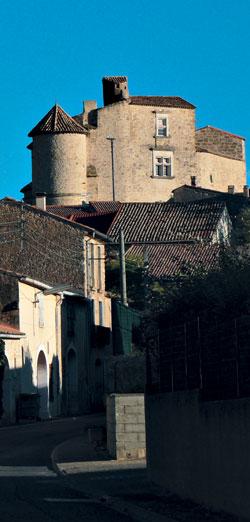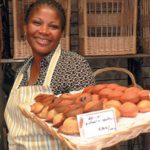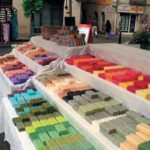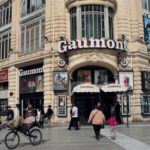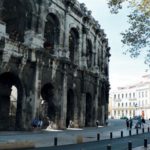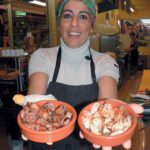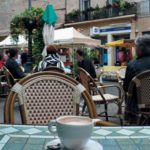Fancy two weeks in southern France with a fleeting visit to Spain? KIM MAXWELL stayed close to the Mediterranean for a personal exploration of time-steeped places and produce
The adventure began in an original feudal village in the south of France. Puissalicon is so small I couldn’t find it on a map, but it’s near Béziers in the Herault. I was travelling with my fiancé Craig, after friends had invited us to join them in a modest holiday home below a very steep cobbled incline.
At the apex, a circular street surrounding a château had only a boulangerie, provision shop and doctor’s office. A couple of wine cellars were situated closer to the surrounding vineyards that fall under the larger Languedoc-Rouissillon region. During a 10-day stay involving a lot of communal cooking, most of our wine came from Domaine La Croix-Belle, run by a Puissalicon family fortwo centuries. Their impressive range included viognier-orientated whites and affordable rustic to smarter red blends.
Internet and phone signals were fleeting, so an uphill walk to buy the day’s baguettes and croissants was usually accompanied by locals’ stares at a couple of out-of-towners checking emails on laptops from the “comfort” of the village bench.The French love roads with roundabouts, and they come in handy when you’re unsure of a turn as you simply continue circling.
Saying this, providing directions to La Roque Margaux restaurant, just 6,5km away outside the village of Servian would be difficult, but the venue deserves a mention for a memorable threecourse set dinner (about €35 including wine) in a beautiful dining room attached to a stylish auberge overlooking hectares of lawns. French and Belgian hosts speak English and serve the most delectable scallops seared in saffron butter from the nearby port of Sète. Delicious! Puissalicon provided a good base for day trips in various directions.
The medieval walled city of Carcassonne was just over an hour’s drive southwest, while Béziers provided modern department stores 25 minutes to the south. Montpellier was an hour north-east; Nîmes, an additional hour in the same direction. Friends advised that Carcassonne was rather touristy, so we opted to explore the smaller medieval town of Pézenas, 25 minutes away. A regular Saturday market was the initial lure, stallholders selling home-grown or homemade produce along a winding street through the town.
Gift shops and ice-cream vendors meandered to another square holding an organic produce section. Among vegetables, fruit and cut flowers, I found wine barrels displaying olives and tapenades, pastries and breads, lavender-infused honey and homemade ginger beer.Nîmes was a two-hour drive from our village, solid French freeways and route directions between destinations on www.viamichelin.com simplifying the journey.
The pedestrianised Old Town is triangular in shape and an architectural delight with its first-century AD Maison Carrée (a Roman square house with Corinthian columns) and Place des Arènes amphitheatre. Amazing buildings with wrought-iron balustrades filled alleyways in between, cafés serving café au lait lining open squares. Incidentally this was the Roman city where denim was invented. It was an early start to meet a tour guide by 9am, but produce doesn’t wait. The Nîmes covered market has operated since 1883, offering an amazing introduction to foodstuffs and specialities of the region.
These included wild and cultivated mussels from Sète alongside Pélardon goat’s milk cheese rounds and chèvre des Cévennes from the north-east countryside. Southern French fruit ranged from melons, peaches and nectarines to figs, and a new variety of black tomatoes called kumatoes. It was an enjoyable experience until a woman lured us to her counter. She insisted we try some local specialities.A breakfast of diced sheep’s testicles and duck hearts sautéed in olive oil, pesto and a splash of balsamic vinegar was hard to stomach, washed down with croutons and local white wine!
“We’re the only restaurant in the market and we open at 6am. People are queuing,” she bragged of the Halles Auberge delicacies. Our next stop on Rue de la Madeleine left a sweeter finish. Baking aromas announced Croquant Villaret bakery, dating back to 1775. Biscuit recipes had been passed down in the family business, and it was impossible to resist the individual touch of thick, rectangular chunks of “le croquant”, and thinner, chewier almond-laced “caladon” square biscuits. Odd animal bits were completely forgotten as we took a lunch table at Nîmes’s best inner-city restaurant, offering a wonderful view of the amphitheatre’s Roman arches.
Chef Olivier Douet and sommelier Stéphane Debaille worked together in other restaurants before settling on Nîmes. Le Lisita was their second venture; a Michelin star awarded in 1996 suggested that the format was working. A set menu offered good value and a refined interpretation of regional produce, lunch being a more affordable option than dinner at €35 for a starter, main (with choices) and dessert or cheese. We’d seen plenty of the Nîmes local salt cod brandade (salt cod puréed with olive oil and milk) at the market, which originated when the Romans traded southern salt for northern Brittany fish.
Le Lisita’s delicious starter of this milk-poached salty fish with olive oil, cream and garlic was served with roasted Cévennes sweet onions. Truffle-scented jus surrounded the taureau (bull) fillet served with vegetables, a nod to the wild bulls traditionally sourced from the marshy Camargue near Nîmes. From the trolley, mature Pélardon goat’s cheese continued the regional theme with crusty baguette, and we finished with a pre-dessert of runny chocolate fondant with mango ice cream and fig halves with gingerbread cake and crème anglaise, as we’d upgraded to the €54 five-course lunch. Montpellier is part of the rugby heartland in southern France, but rugby isn’t all this town is good for. A single day trip wasn’t long enough to explore the inner city’s magnificent buildings and majestic streets. Montpellier’s outlying suburbs are characterised by nondescript modern buildings and fast-food chains, but a tram trip past university buildings to Place de la Comédie in the centre of the Old Town displayed a definite injection of style and wealth.
Wide pedestrian tree-lined sections and fountains welcomed sociable locals ordering coffees or lunch at cafés, impressively old four- or five-storey buildings behind them. Wandering past windows displaying Hugo Boss suits and Marc Jacobs shoes, we eventually located Le Vieux Four Sainte Anne, an artisanal bakery down a winding lane. Beside a 200-year-old oven, French flair showed in homemade breads including pain aux raisins and pain au gingembre confit (ginger preserve bread), culminating in a huge rectangular sourdough loaf weighing seven kilograms!
The sweet Madeleine cakes were fun, but my lunch vote that day went to the savoury saltiness of a rustic fougasse wholewheat flatbread baked with diced duck meat, and a salami pizza topped with Provence herbs on possibly the best fresh tomato sauce ever made.
We left full-cream French cheeses temporarily and journeyed a little more than two hours through hillier terrain into north-eastern Spain. After an application for a reservation 15 months earlier had been successful, we were meeting foodie friends for dinner at El Bulli restaurant outside Roses on the Costa Brava coastline. The home of molecular gastronomy, El Bulli opens its doors for six months of the year and doesn’t serve lunch. After sampling the 32-course menu (€185) created for our table and experiencing labour-intensive, painstakingly fashioned dishes first hand, it’s easy to understand why.
A chef friend had warned that we wouldn’t necessarily like everything served, but we’d appreciate the effort. He was spot on. A lot of the meal involved using our hands, and there was as much to absorb as an intellectual and sensory experience, as dishes aimed specifically at the taste buds. Offerings from the sea were my favourites, including cold razor clams with different seaweeds,mackerel belly served teriyaki-style with interesting accompaniments, and tiny Spanish clams pumped with “air” to deliver a swoosh of warm sea juices when chewing.
From cool cocktails topped with warm foam to dishes infused with local forest pine needles and sweet extras reminiscent of Turkish Delight and chocolate surrounding egg-white marshmallow, the meal was flavourful and delightfully interesting, if puzzling at times. It’s amazing that Roses should have any good restaurants. The Spanish town capitalises on luring tourists to holiday flats and hotels past their heyday, linked to a long stretch of beach in a Durban coastline kind of way. The challenge is to negotiate through the tacky tourist picture menus.
But after a few twists and turns on foot, we tracked down a great spot called Rafa’s. It was the most delightful seafood lunch our group had eaten; the genius in its simplicity. Eating on rustic tablecloths with paper napkins, we pried pre-cooked sea snails from their shells into olive oil and lemon juice with chunks of baguette. Deliciously tender squid tubes and tentacles lying in ink were seared in olive oil. We selected from a choice of whole John Dory, sea bream, rascasse and monkfish, also thrown on the grill.
The sea bream was so fresh we found a fish hook! By the time we’d added local white wine and espressos to our bill, Señora was smiling through her usual siesta time and serving complimentary nibbles. Back in France, we headed to Marseille. Set along the coast, sections of Marseille’s showier side reminded me of Camps Bay. Its dappled history dates to 600BC, playing a part in Greek, Roman and Christian eras.
The moving “La Marseillaise” French anthem has its origins in a 600-strong march from Marseille to Paris during the revolution. Budgets were again ignored in favour of a €180 seafood tasting menu at plush Le Petit Nice, a two Michelin-star restaurant. There were 13 courses of beautiful fiddly food, offering unusual flavour juxtapositions such as local fish with baby carrots and courgettes – the latter in minutely sliced strips or foams.
The cheese trolley was neglected as Marseille’s plentiful fish and seafood array offered a greater learning experience. An unusual ice-cream dessert included the liquorice flavours of Marseille’s Pastis anise liqueur. There was only one more thing to tick off the list: bouillabaisse. We were sent to Restaurant Miramar at Vieux Port, the old harbour, where fishermen sell the day’s catch. The dish originated from fishermen selling their better large fish and keeping the small ones. Hence the thick stock was fashioned from a variety of smaller fish, cooked with garlic, fennel, tomato, saffron and Pastis.
We tried the famous soup with baguette croutons and garlic-laced aïoli. Potatoes and fillets of six local fish were cooked in the soup for the final fishy chunk serving. The portion was extremely filling for two to share, but the flavours were sincere, rustic and bursting with Mediterranean sunshine. It was a fitting way to finish an exploration of the south of France.

